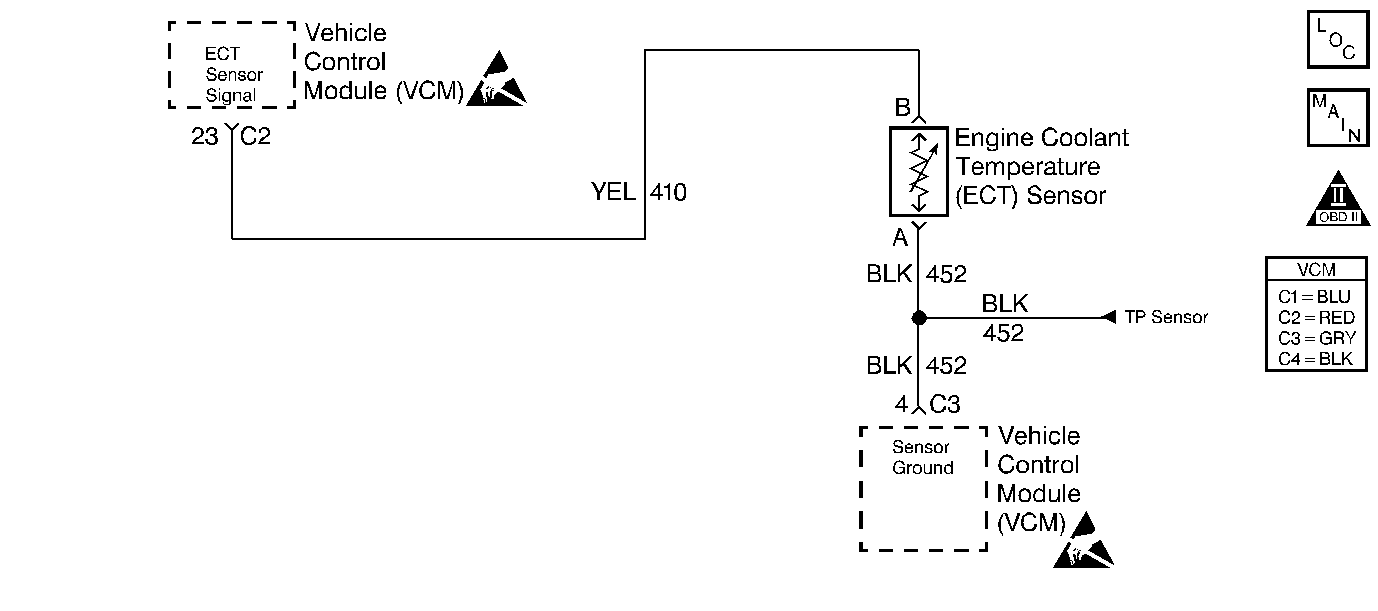
Circuit Description
The Engine Coolant Temperature (ECT) sensor is a thermistor which controls the signal voltage to the VCM. The VCM applies a voltage on a 5 volt reference circuit to the sensor. When the engine coolant is cold, the sensor's internal resistance is high resulting in a high voltage ECT Sensor Signal. As the engine coolant temperature increases, the sensor's internal resistance and ECT Sensor Signal decrease. This DTC is a type A DTC.
Conditions for Setting the DTC
The following conditions will set the DTC:
| • | The engine run time is greater than 5 seconds |
| • | The ECT signal voltage indicates an ECT voltage above 4.90 volts |
Action Taken When the DTC Sets
The VCM turns ON the MIL when this DTC is reported and 1 failure has occurred.
Conditions for Clearing the MIL or DTC
| • | The control module turns OFF the MIL after 3 consecutive drive trips when the test has run and passed. |
| • | A history DTC will clear if no fault conditions have been detected for 40 warm-up cycles. A warm-up cycle occurs when the coolant temperature has risen 22°C (40°F) from the startup coolant temperature and the engine coolant reaches a temperature that is more than 70°C (158°F) during the same ignition cycle. |
| • | Use a scan tool in order to clear the DTCs. |
Diagnostic Aids
Check the harness routing for a potential short to ground in the 5 volt reference circuit. After starting the engine, the temperature should rise steadily to about 90°C (194°F), then stabilize when the thermostat opens.
Use the Temperature vs Resistance Value table in order to test the coolant sensor at various temperature levels in order to evaluate the possibility of a skewed (mis-scaled) sensor. A skewed sensor could result in poor driveability complaints. Refer to Temperature vs Resistance .
Test Description
The numbers below refer to the step numbers on the diagnostic table.
-
If the fault is present, the engine coolant temperature voltage measures greater than 4.90 volts.
-
This test simulates the conditions for a DTC P0117. If the VCM recognizes the grounded circuit (low voltage) and displays a low voltage message, the VCM and the wiring are okay.
-
This test checks for an open or grounded signal sensor circuit. Also being checked are the ECT sensor ground circuit and the VCM.
-
This test checks for a short to voltage on the ECT signal circuit.
-
After repairing a short to voltage, it is necessary to recheck the operation of the ECT sensor.
Step | Action | Value(s) | Yes | No |
|---|---|---|---|---|
1 |
Important: Before clearing the DTCs, use the scan tool in order to record the Freeze Frame and the Failure Records for reference. This data will be lost when the Clear DTC Information function is used. Was the Powertrain On-Board Diagnostic (OBD) System Check performed? | -- | ||
Does the scan tool display an ECT sensor voltage greater than the specified value? | 4.9 V | |||
Does the scan tool display an ECT sensor voltage less than the specified value? | 0.82 V | |||
Jumper the ECT sensor signal circuit to a known good ground. Does the scan tool display an ECT sensor voltage less than the specified value? | 0.82 V | |||
Use a DVM J 39200 in order to check the voltage between the ECT sensor signal circuit and a known good ground. Is the voltage greater than the specified value? | 5.20 V | |||
6 | The DTC is intermittent. Are any additional DTCs stored? | -- | Go to the applicable DTC table | Go to Diagnostic Aids |
7 | Inspect the ECT sensor connector and the VCM connector for a proper connection. Was a problem found? | -- | ||
8 | Check the ECT sensor ground circuit for an open between the ECT sensor and the VCM. Was a problem found? | -- | ||
9 | Check the ECT sensor signal circuit for an open between the ECT sensor and the VCM. Was a problem found? | -- | ||
10 | Repair the short to voltage in the ECT sensor signal circuit. Refer to Wiring Repairs in Electrical Diagnosis. Is the action complete? | -- | -- | |
11 | Repair the circuit as necessary. Refer to Wiring Repairs in Electrical Diagnosis. Is the action complete? | -- | -- | |
Does the scan tool display an ECT sensor voltage less than the specified value? | 4.90 V | |||
13 | Replace the ECT sensor. Refer to Engine Coolant Temperature (ECT) Sensor Replacement . Is the action complete? | -- | -- | |
14 | Replace the VCM. Important: When replacing the VCM, the VCM will need to be programmed. Refer to VCM Replacement/Programming (With KS Calibration PROM) . Is the action complete? | -- | -- | |
15 |
for setting this DTC as specified in the supporting text. Does the scan tool indicate that this diagnostic ran and passed? | -- | ||
16 | Use the scan tool in order to display the Capture Info and the Review Capture Info functions. Are there any DTCs displayed that have not been diagnosed? | -- | Go to the applicable DTC table | System OK |
